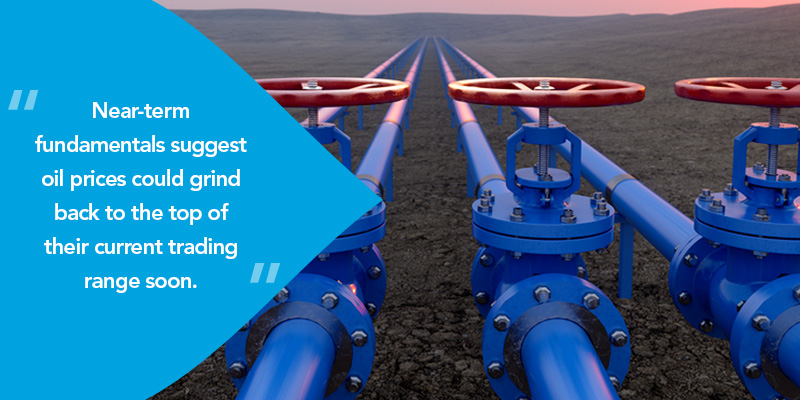Devil's advocate
Could energy buck conventional wisdom?
Bottom Line
It’s been a brutal year so far for the energy complex. The S&P 500 has risen 13.6% on a price-only basis, largely paced by technology stocks’ nearly 40% surge. Energy stocks, however, have plunged 11.5%, led by a 20% collapse in crude oil prices (West Texas Intermediate, or WTI) to about $69 per barrel over the past two months. While high-flying tech equities are trading at frothy valuation levels, bottom-dwelling energy stocks are languishing with single-digit P/E’s and dividend yields twice the broad market.
Why is this happening? The Federal Reserve’s aggressive tightening campaign that has launched the fed funds rate from zero to an upper band of 5.25% to reverse the worst inflation in the U.S. in more than 40 years is beginning to work. Nominal CPI inflation has been more than halved over the past year. In its wake, economic growth is slowing, with an elevated risk of recession perhaps next year. Europe is in recession now, and China’s expected economic rebound has been slow to materialize.

At the same time, the Biden administration and other climate warriors have pushed to accelerate the transition to renewable energy from fossil fuels, raising fears about the growing threat of peak oil over the next decade. Consequently, energy companies have been reluctant to expand exploration and production activities, opting instead to return cash flows to investors.
Energy volatility When President Biden was elected in November 2020, crude oil was trading just under $34 per barrel and unleaded gasoline sat at $2.10 per gallon. Over the next 15 months, prices soared to $100 and $3.57, respectively. That was prior to Russia’s invasion of Ukraine in February 2022. After the war started, WTI spiked 30% to $130 per barrel in March. It has since declined 48% to $69, locked in a relatively tight $63-83 trading range this year. Gasoline hit $5.02 per gallon in June 2022, but has since declined to around $3.60.
Energy decline paces moderating inflation Nominal CPI inflation was only 1.4% year-over-year (y/y) in January 2021 when President Biden took office, but it surged to a 41-year high of 9.1% in June 2022. Thanks to the Fed’s aggressive rate hikes, however, it has declined to 4% in May 2023. Energy commodities (such as fuel oil, motor fuel and all grades of gasoline) account for only 3.7% of the total weight of the CPI index, but they plunged by more than 20% y/y, accounting for much of the improvement in headline inflation over the past year. In contrast, core CPI (which excludes volatile energy and food costs) peaked at a 40-year high of 6.6% in September 2022, and has since declined to 5.3% in May 2023.
What about the short-term picture? While there are longer-term questions regarding the supply/demand balance for energy, near-term fundamentals suggest WTI could grind back to the top of its current trading range over the next six to 12 months:
- Continued dollar weakness After two years of strength, the dollar has weakened over the past nine months against the euro, pound and yen by 15%, 25% and 5%, respectively, as the Fed slowed its pace of rate hikes. We expect the Fed to reach its terminal fed funds rate at 5.75% within the next six months. Hard commodities like oil tend to trade inversely to the strength or weakness of the dollar.
- U.S. and EU price caps of $60 per barrel on Russian crude exports have had a negligible impact Russia has eliminated oil production and sales to the G-7 nations, cutting their overall oil production by a half million barrels per day. But it is selling as much oil as they want to the two most populous countries in the world (India and China), who do not share U.S. environmental policies.
- OPEC+ cuts crude oil production by 4.66 million barrels per day The cartel expects those cuts (or perhaps more) to last through the end of 2024. As the largest producer within OPEC+, Saudi Arabia has targeted a price above $81 per barrel, to meet their own internal budget needs.
- China stumbles from its self-imposed Covid lockdown China ended its lockdown, hoping to get GDP to 5% this year and perhaps 6-8% next year. But growth has disappointed thus far, and we expect China to implement monetary and fiscal stimulus to reverse their flagging economy. Stronger growth from the world’s second-most populous country (India has surpassed it) with the second strongest economy (behind the U.S.) should result in higher demand for crude oil, forcing prices higher.
- Potentially difficult weather Now that we’re past Memorial Day, we’re expecting a hot summer and a busy vacation driving season. Meteorologists are predicting an El Nino weather pattern in the U.S., which could usher in an active hurricane season. Finally, we dodged a bullet with a very easy winter in the northeast and Midwest last year. To channel our inner Clint Eastwood, “are we feeling lucky, punk?” A colder, more normal winter will collectively spark stronger energy demand for heating.
- We still have not refilled our Strategic Petroleum Reserve (SPR) President Biden reduced our SPR to 370 million barrels last year (roughly half of full capacity of 727 million barrels), to reduce $5 per gallon gas prices ahead of the midterm elections. That’s a 40-year low, leaving us with only a few months of capacity in the event of an emergency. The administration said it will replace the oil by purchasing it at $67-72 per barrel in the open market, but that hasn’t happened yet. For what exactly are we waiting?
- Oil companies shift their focus from E&P to shareholders Given the Biden administration’s climate policies, domestic energy companies have reduced their rig counts and are more focused on share repurchases and dividend increases.